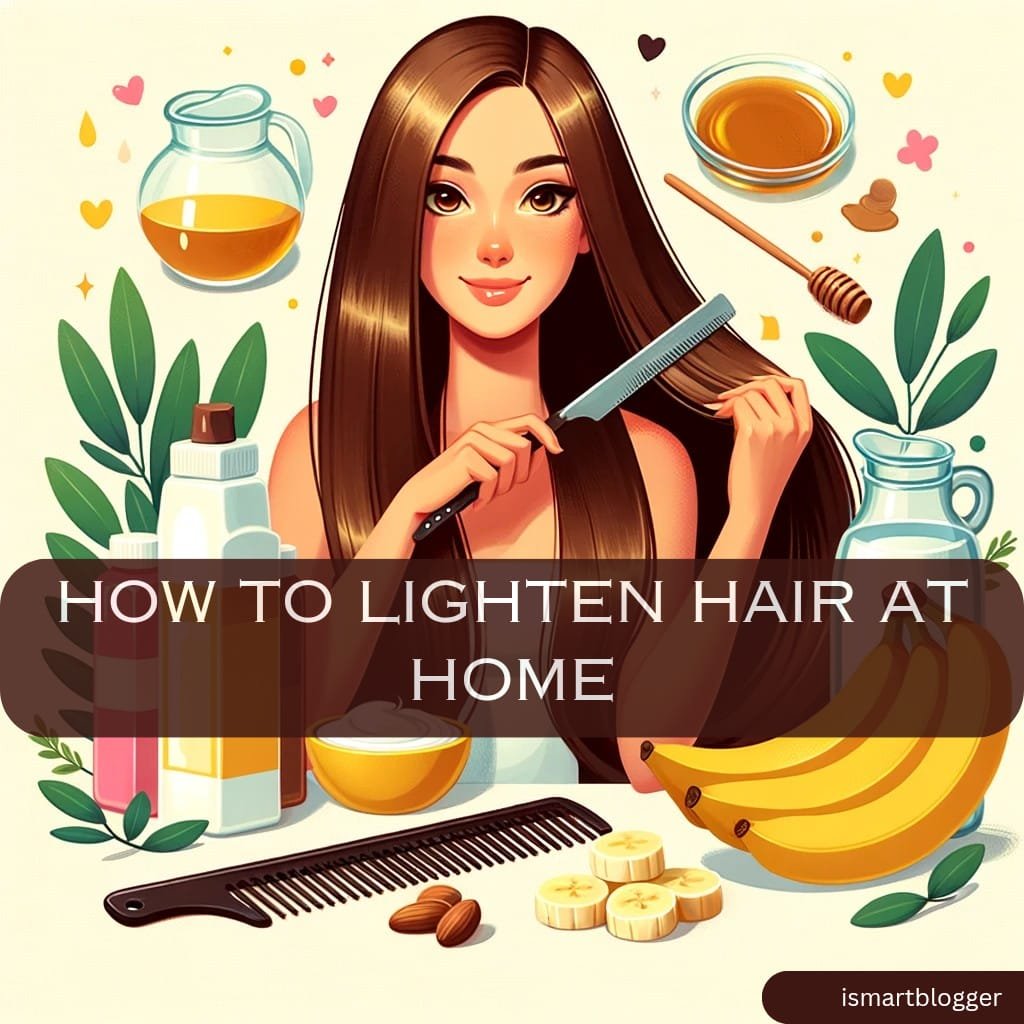Introduction
The Quest for Lighter Hair: Unlocking Nature’s Secrets
Throughout history, the pursuit of lighter hair has captivated the hearts and minds of countless individuals. Whether driven by a desire for a fresh look, a trendy style, or simply to enhance their natural beauty, people have sought various methods to achieve hair that exudes radiance and luminescence.
In recent times, there has been a growing inclination towards seeking natural alternatives rather than resorting to harsh chemical treatments. This shift is not only fueled by concerns about potential hair damage but also by the yearning to embrace the goodness that nature offers. “For centuries, civilizations across the globe have discovered age-old remedies to harness nature’s power in lightening hair.”
Brief Overview: The Allure of Lighter Locks
Lightened locks are like rays of sunshine dancing on one’s head – effortlessly chic and undeniably captivating. The desire for lighter hair stems from an innate fascination with luminosity that goes beyond mere aesthetics; it evokes feelings of youthfulness, vitality, and an undeniable sense of self-expression.
From ancient civilizations such as Egypt and Greece to modern-day fashion icons gracing runways worldwide, lighter hair has remained an enduring trend. It adorns countless heads in shades ranging from sun-kissed blonde to honeyed caramel, symbolizing beauty in its purest form. “The allure lies not only in the transformation itself but also in the journey taken to attain it.”
Advantages of Natural Methods over Chemical Treatments
In recent years, individuals have become increasingly conscious about what they put on their bodies as well as into them. This shift towards embracing natural alternatives has extended to hair care practices, with a growing preference for gentle and sustainable solutions. Natural methods to lighten hair offer several distinct advantages over chemical treatments:

1. Nurturing the Health of Your Hair
Natural lightening methods, unlike chemical treatments, tend to be less harsh and damaging to the hair shaft. Many chemicals used in commercial products strip the hair of its natural oils and proteins, leaving it dry, brittle, and vulnerable to breakage.
On the other hand, natural methods often utilize ingredients that not only lighten the hair but also nourish and strengthen it from within. 2. Embracing Mother Nature’s Palette
Natural lightening agents harness the power of various plants, fruits, and other organic substances that have been trusted by civilizations for centuries.
By utilizing nature’s own palette of botanicals and herbs, these methods offer a more holistic approach towards enhancing one’s appearance without compromising on authenticity. 3.
Freedom from Harmful ChemicalsSynthetic hair-lightening products often contain harmful chemicals such as ammonia or hydrogen peroxide that can cause scalp irritation or allergic reactions in some individuals.
Natural methods provide a safer alternative for those who value their well-being and seek to avoid exposure to potentially toxic substances. As we embark on this journey through nature’s tapestry of lightening secrets, let us explore eight fascinating natural ways that can illuminate your tresses while honoring your health and well-being.
Lemon Juice
Explanation of how lemon juice works as a natural lightener
Lemon juice, a popular and effective natural hair lightener, contains citric acid, which acts as a bleaching agent. When applied to the hair, the citric acid in lemon juice opens up the hair cuticles and breaks down the melanin pigments responsible for hair color.
As a result, the hair gets gradually lighter over time. The acidity of lemon juice also helps to remove excess oil and product buildup from the scalp, promoting healthier hair growth.
Step-by-step guide on using lemon juice to lighten hair
To lighten your hair with lemon juice, follow these simple steps: 1. Squeeze fresh lemons to obtain about half a cup of lemon juice. 2. Dilute the lemon juice by mixing it with an equal amount of water or conditioner if you have dry or damaged hair.
3. Pour the mixture into a spray bottle for easy application. 4. Shampoo your hair as usual and rinse well.
5. Spritz or apply the diluted lemon juice evenly throughout your damp or towel-dried hair. 6. Comb through your strands to ensure even distribution.
7. For better results, expose your treated hair to sunlight or use heat tools like blow dryers or flat irons on low heat settings to activate the lightening properties of lemon juice. 8. Leave the mixture in your hair for about 30 minutes to an hour before rinsing thoroughly with cool water.
Mixing lemon juice with water or conditioner for application
When using lemon juice as a natural lightener for your hair, it is essential to dilute it with either water or conditioner depending on your specific needs. If you have oily scalp and normal-to-oily type of locks: Mixing equal parts of freshly squeezed lemon juice and water will provide the right balance to effectively lighten your hair.
The water helps prevent excessive drying and irritation on your scalp. If you have dry or damaged hair:
Instead of water, mix the lemon juice with a good-quality conditioner. This combination helps nourish and moisturize dry strands while still benefiting from the lightening properties of lemon juice.
Ensure that the conditioner is free from any silicones or heavy oils that may interfere with the lightening process. Remember, always conduct a patch test before applying any mixture to your entire head to check for any adverse reactions or allergies.
Sun exposure and heat activation for better results
After applying lemon juice to your hair, exposing it to sunlight can enhance its lightening effects. The UV rays from the sun speed up the bleaching process by amplifying the action of citric acid on melanin pigments. However, it’s important to note that prolonged sun exposure can damage your hair if not protected adequately with sunscreen or a hat.
Additionally, if you want faster results without relying solely on sunlight, you can use heat tools like blow dryers or flat irons on low heat settings after applying lemon juice. The heat helps open up the hair cuticles further, allowing deeper penetration of lemon juice into each strand for more noticeable lightening effects.
Remember to apply a heat protectant spray before using any hot tools to minimize potential damage caused by excessive heat. By following these steps and incorporating sun exposure or mild heat activation techniques, you can effectively harness the natural lightening power of lemon juice for beautifully sun-kissed strands at home!
Chamomile Tea
Chamomile tea has long been known for its soothing properties and therapeutic benefits. However, it also possesses remarkable lightening properties that can enhance the natural color of your hair, giving it a sun-kissed glow. The main active ingredient in chamomile tea responsible for this lightening effect is a compound called apigenin.
Apigenin helps to gradually lighten the hair by breaking down the melanin pigment present in the hair shafts. Apart from its ability to lighten hair, chamomile has numerous benefits for the overall health of your precious locks.
It possesses anti-inflammatory properties that help soothe an irritated scalp and reduce dandruff, promoting healthy hair growth. Chamomile tea also contains antioxidants that protect the hair from damage caused by free radicals, environmental stressors, and styling heat.
To make a chamomile tea rinse or spray at home, start by brewing a strong cup of chamomile tea using dried chamomile flowers. Allow it to cool completely before using it on your hair.
For a rinse, after shampooing and conditioning your hair as usual, pour the cooled chamomile tea over your head while gently massaging it into the scalp. Let it sit for at least 15 minutes before rinsing it out with cool water.
For a spray, fill a clean spray bottle with cooled chamomile tea and mist it onto damp or dry hair whenever desired. It’s important to note that while chamomile is generally safe for most people to use on their hair, those with allergies or sensitivities should exercise caution and do a patch test before applying it all over their scalp.
Additionally, bear in mind that natural lightening results may vary depending on individual factors such as starting hair color and texture. Incorporating chamomile tea into your regular hair care routine can offer you not just lighter locks, but also healthier and more vibrant hair.
Its lightening properties, combined with its numerous benefits for scalp health, make it a fantastic natural alternative to chemical hair lightening methods. So go ahead, indulge in the gentle power of chamomile tea and embrace the natural radiance that it can bring to your tresses.
Honey
Explanation of honey’s natural bleaching effect due to its enzyme content
Honey, apart from being a delicious natural sweetener, possesses remarkable properties that can help lighten hair. Its natural bleaching effect is primarily attributed to the presence of enzymes like glucose oxidase and catalase. These enzymes work together to break down the pigment melanin in the hair shaft, thus lightening its color over time.
Additionally, honey contains traces of hydrogen peroxide, a well-known hair lightening agent found in many commercial products. When applied to the hair, honey gently lifts the existing color and gradually adds subtle highlights.
It is worth noting that since honey is a mild lightener, its effect may be more noticeable on lighter or naturally blonde hair compared to darker shades. However, repeated applications can still yield noticeable results for brunettes or those with darker locks.
Step-by-step guide on creating a honey mask or treatment for lightening hair
Creating a homemade honey mask or treatment to lighten your hair is an easy and enjoyable process. Here’s a step-by-step guide to help you achieve desirable results:
Step 1: Gather your ingredients – Pure raw honey (avoid processed varieties)
– A conditioner (preferably one without silicones) – A mixing bowl
– A spoon or whisk for stirring Step 2: Mix the ingredients
– In the mixing bowl, combine three parts conditioner with one part pure raw honey. – Stir or whisk well until you achieve a smooth and consistent mixture.
– Adjust the quantities depending on your hair length and thickness; ensure you have enough mixture to fully cover your strands. Step 3: Prepare your hair
– Shampoo your hair as usual and gently towel-dry until it is damp but not dripping wet. Step 4: Apply the honey mask
– Divide your hair into sections to ensure even application. – Using your fingers or a dye brush, apply the honey mask generously from roots to ends, coating each strand thoroughly.
– Massage the mixture into your hair and scalp, ensuring every inch is covered. Step 5: Allow for processing time
– Once applied, cover your hair with a shower cap or wrap it in plastic wrap to create a warm environment. – Let the honey mask sit for at least two hours.
For more intense results, you can leave it on overnight. Remember that natural lightening processes may take time and require multiple applications.
It is advisable to perform a patch test beforehand to check for any adverse reactions. Enjoy this pampering process while trusting in the power of nature and honey’s ability to bring out beautiful highlights in your hair.
Cinnamon and Honey Paste
A Dynamic Duo for Lightening Hair
When it comes to natural hair lightening remedies, cinnamon and honey are a powerful combination. Cinnamon, with its warm, spicy aroma and magical properties, serves as an effective lightening agent when blended with the nourishing goodness of honey. This natural hair lightening paste not only adds gorgeous highlights to your locks but also provides essential nutrients that promote hair health.
So, let’s dive into how you can create and apply this enchanting cinnamon and honey paste for lusciously lighter hair. To make the cinnamon and honey paste, you’ll need just a few simple ingredients that are probably already in your kitchen pantry.
Start by combining two tablespoons of cinnamon powder with four tablespoons of organic honey in a mixing bowl. Make sure to use pure honey since it contains the enzymes necessary for effective lightening.
Whisk the mixture thoroughly until you achieve a smooth consistency. Once your paste is prepared, it’s time to apply it to your tresses.
Begin by washing your hair with a gentle sulfate-free shampoo and towel-drying it until slightly damp. Divide your hair into sections for easy application.
Using a tinting brush or gloved hands, generously coat each strand from root to tip with the cinnamon and honey paste. After applying the mixture evenly throughout your hair, gently massage your scalp to ensure optimal penetration of the concoction’s beneficial ingredients.
Once you’ve covered every strand, carefully twist your hair into a bun or secure it with a clip for easier handling during the processing time. Now comes the waiting game!
Allow the cinnamon and honey paste to work its magic on your strands for at least three hours—though leaving it overnight can yield even better results if you’re comfortable doing so—before rinsing thoroughly with lukewarm water. Remember that this method requires patience as gradual lightening occurs over multiple applications.
Consistency is key when using natural lightening methods. Harnessing the power of nature, this cinnamon and honey paste provides a gentle yet effective route to hair lightening without the use of harsh chemicals.
Moreover, it bestows your mane with added shine and nourishment, ensuring your locks remain healthy throughout the process. So why not embark on this delightful journey toward sun-kissed strands by embracing the wonders of cinnamon and honey?
Apple Cider Vinegar (ACV)
An Ancient Elixir for Lighter Locks
Apple Cider Vinegar (ACV) is a time-honored natural remedy that not only boasts numerous health benefits but also works wonders in enhancing hair color naturally. ACV is renowned for its acidic properties, which help remove product buildup, excess oils, and impurities from the hair and scalp. By effectively clarifying the hair follicles, ACV allows your natural hair color to shine through, resulting in lighter and brighter locks.
A Step-by-Step Guide for an ACV Rinse
To harness the power of ACV to lighten your hair, follow these simple steps:
- Start by diluting the ACV with water. Mix one part ACV with two parts water in a spray bottle or bowl.
- Ensure your hair is clean and damp before applying the mixture. Shampoo and rinse thoroughly beforehand.
- Section your hair into manageable parts to ensure even application. Spray or pour the diluted ACV mixture onto your scalp and throughout your strands.
- Gently massage your scalp to distribute the solution evenly and stimulate blood circulation.
- Leave the mixture on for about 10-15 minutes to allow it to penetrate deeply into the hair cuticles.
- Rinse your hair thoroughly with lukewarm water until all traces of vinegar are removed.
- You can follow up with a conditioner or apply a leave-in treatment if desired.
For optimal results, repeat this process once or twice a week over a period of several weeks, depending on your hair’s responsiveness. Remember to adjust the amount of ACV used based on the length and thickness of your hair, as too much acidity can cause dryness or irritation. By incorporating ACV rinses into your hair care routine, you not only lighten your tresses naturally but also promote healthy hair growth and balance the pH levels of your scalp, resulting in a more vibrant and lustrous appearance.
Rhubarb Root
Description of rhubarb root’s lesser-known lightening properties
Rhubarb root, commonly used in culinary delights and desserts, possesses lesser-known properties that can aid in lightening hair naturally. This herbaceous perennial plant, known for its vibrant red stalks, contains natural compounds like anthraquinones and emodin.
These compounds have the potential to lighten hair by gently stripping away some of the color pigments present. While not as widely recognized for its ability to lighten hair as other methods, rhubarb root can produce subtle yet noticeable results, particularly on lighter or more porous hair.
Instructions on creating a rhubarb root infusion or mask
To create a rhubarb root infusion for lightening your hair, follow these simple steps: 1. Begin by obtaining fresh or dried rhubarb roots from a trusted source. If using fresh roots, ensure they are thoroughly washed and scrubbed.
2. Chop the rhubarb roots into small pieces to increase surface area and promote better extraction of its active compounds. 3. In a pot, bring water to boil and add the chopped rhubarb roots.
4. Allow the mixture to simmer gently for approximately 30 minutes to extract the beneficial properties. 5. Remove the pot from heat and let it cool down completely.
6. Once cooled, strain the liquid into a clean container using cheesecloth or a fine-mesh strainer to remove any solid particles. 7. Your homemade rhubarb root infusion is now ready for use.
To apply the infusion as a hair rinse: 1. Thoroughly shampoo your hair and rinse it well with warm water.
2. Pour the cooled rhubarb root infusion over your damp hair while massaging it into your scalp. 3. Leave it on for about 20-30 minutes before rinsing it out with cool water.
4. Repeat this process a few times a week until you achieve your desired lightening effect. Alternatively, you can create a rhubarb root hair mask:
1. In a bowl, combine 2-3 tablespoons of rhubarb root infusion with an equal amount of plain yogurt or honey to form a thick paste. 2. Apply the mask generously to your clean, dry hair, focusing on the areas you wish to lighten.
3. Cover your hair with a shower cap or towel and leave the mask on for approximately 1-2 hours. 4. Rinse your hair thoroughly with lukewarm water and follow up with a gentle shampoo and conditioner.
Remember that natural remedies may take time to show results, so patience is key. It’s also important to perform patch tests before applying any product extensively to ensure you do not have any adverse reactions or allergies.
Black Tea
Black tea, derived from the Camellia sinensis plant, is not only a popular beverage but also a powerful natural remedy for lightening hair. The tannins present in black tea have the ability to darken or lighten hair depending on how it is used.
These tannins work by binding to the hair strands and altering their color. While black tea may not produce dramatic lightening results like lemon juice or chamomile, it can subtly enhance your natural highlights and add depth to your hair.
Step-by-Step Guide on Preparing Black Tea Rinse or Spray
To achieve the desired lightening effects with black tea, follow these simple steps: 1. Prepare the Black Tea Mixture: Start by boiling two cups of water and adding three to four black tea bags.
Allow the tea bags to steep for approximately 20 minutes until a strong infusion is obtained. 2.
Cool Down and Strain: After removing the tea bags, let the mixture cool down completely before straining out any remaining particles. 3.
Application: It’s time to apply the black tea mixture onto your hair while ensuring even distribution. You can use either a spray bottle or a bowl with a brush for this purpose.
a) For Rinse: Use clean, freshly washed hair as a starting point. Pour the cooled-down black tea mixture over your head and massage it into your scalp gently.
Let it sit for about 15 minutes before rinsing thoroughly with lukewarm water. b) For Spray: Pour the strained liquid into a spray bottle and mist your entire head of hair generously.
Make sure to cover all areas evenly. Allow the black tea to remain in your hair for at least an hour before rinsing it off with lukewarm water.
4. Repeat and Maintain: For noticeable lightening effects, it is necessary to repeat this process several times over a few weeks.
However, be mindful not to exceed more than twice a week as excessive use of black tea can lead to dryness. Remember, the lightening effect achieved with black tea may vary depending on your hair type and natural color.
It is ideal for those seeking subtle highlights or a darker shade rather than drastic transformations. Give it some time and observe how your hair responds to determine the frequency that works best for you.
Conclusion
Recapitulation of the eight natural hair lightening methods
Throughout this article, we have explored eight effective and natural ways to lighten your hair at home. By harnessing the power of nature’s ingredients, you can achieve beautiful, sun-kissed locks without resorting to harsh chemicals or expensive salon treatments. We started with lemon juice, a citrus wonder that can brighten your hair with its natural bleaching properties.
Mixing lemon juice with water or conditioner and exposing your hair to sunlight can yield subtle yet noticeable results over time. Chamomile tea, another impressive remedy, not only imparts a golden glow to your tresses but also promotes overall hair health.
Whether you choose a rinse or a spray, incorporating chamomile into your hair care routine is sure to add radiance and shine. Honey is more than just a delicious treat; it possesses enzymes that gently bleach the hair while nourishing it.
The combination of honey and cinnamon creates a paste that enhances the lightening effects, providing an aromatic treatment for those seeking naturally sunlit locks. Apple cider vinegar (ACV) has long been celebrated for its clarifying properties and ability to remove product buildup.
As an added bonus, using ACV as a rinse can gradually lighten your hair while restoring its natural pH balance. Rhubarb root may be lesser-known in the realm of hair lightening methods but should not be overlooked.
Infusing rhubarb root or creating a mask from it can offer surprising results by subtly brightening darker shades of hair. For those looking for an alternative method to lighten their strands without resorting to harsh chemicals or high-cost treatments, black tea offers a viable solution.
Its tannins darken or lighten the hair depending on usage and provide an easy-to-use option for achieving desired shades. Nature has bestowed upon us various ingredients that can work wonders in lightening our hair at home.
Experiment with these natural methods, and observe the magic they can create in transforming your hair color. Embrace the power of nature, revel in the process, and let your hair shine with confidence and radiance.





